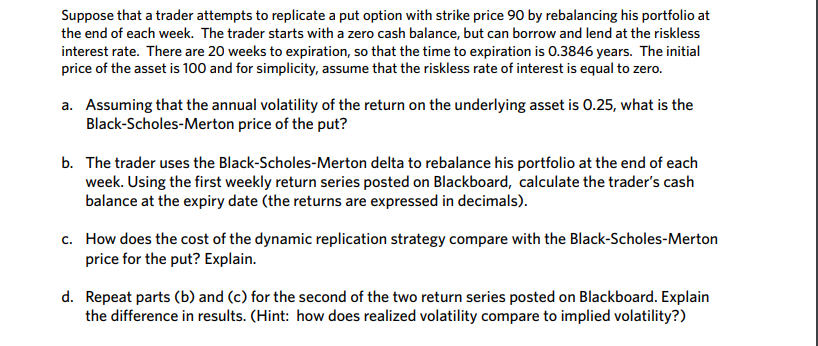
Suppose that a trader attempts to replicate a put option with strike price 90 by rebalancing his portfolio at the end of each week. The trader starts with a zero cash balance, but can borrow and lend at the riskless interest rate. There are 20 weeks to expiration, so that the time to expiration is 0.3846 years. The initial price of the asset is 100 and for simplicity, assume that the riskless rate of interest is equal to zero. a. Assuming that the annual volatility of the return on the underlying asset is 0.25, what is the Black-Scholes-Merton price of the put? b. The trader uses the Black-Scholes-Merton delta to rebalance his portfolio at the end of each week. Using the first weekly return series posted on Blackboard, calculate the trader's cash balance at the expiry date (the returns are expressed in decimals). C. How does the cost of the dynamic replication strategy compare with the Black-Scholes-Merton price for the put? Explain. d. Repeat parts (b) and (c) for the second of the two return series posted on Blackboard. Explain the difference in results. (Hint: how does realized volatility compare to implied volatility?) Suppose that a trader attempts to replicate a put option with strike price 90 by rebalancing his portfolio at the end of each week. The trader starts with a zero cash balance, but can borrow and lend at the riskless interest rate. There are 20 weeks to expiration, so that the time to expiration is 0.3846 years. The initial price of the asset is 100 and for simplicity, assume that the riskless rate of interest is equal to zero. a. Assuming that the annual volatility of the return on the underlying asset is 0.25, what is the Black-Scholes-Merton price of the put? b. The trader uses the Black-Scholes-Merton delta to rebalance his portfolio at the end of each week. Using the first weekly return series posted on Blackboard, calculate the trader's cash balance at the expiry date (the returns are expressed in decimals). C. How does the cost of the dynamic replication strategy compare with the Black-Scholes-Merton price for the put? Explain. d. Repeat parts (b) and (c) for the second of the two return series posted on Blackboard. Explain the difference in results. (Hint: how does realized volatility compare to implied volatility?)







